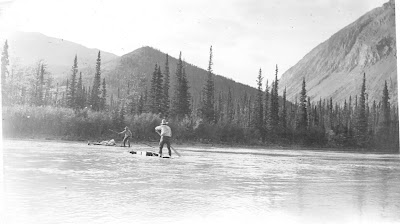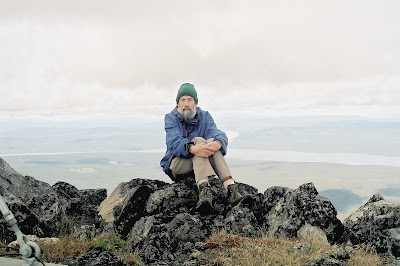Bannock and Beans
A Cowboy’s Account of the Bedaux Expedition
Bob White
Edited, with Foreword and Afterword, by Jay Sherwood
Published by The Royal BC Museum
REVIEW: BANNOCK AND BEANS
In many ways I found Bob White's Bannock and Beans an enigmatic read, a tale of almost daily heroism in battling the elements of winter in back-woods British Columbia, frequent immersion in freezing waters, often blighted by hunger and disappointment and seemingly at all times, a struggle to survive. And yet at the same time, it is also a chronicle of doing the same sort of things, day after day, month after month – blazing trails through harsh environments, setting up camp often in harsh elements, finding and wrangling horses, making rafts to ford rivers, brief meetings with equally lonely souls in desolated places, hunting for food, and the joy of returning to pockets of civilization. If I have one criticism of this book, it is that I think that it would have been richer, and infinitely more exciting, with more judicious editing and paraphrasing of this period in the rich life and fascinating experiences of Bob White, rather than a blow-by-blow account which sometimes dulls the mind through its 'sameness of occasion'. That said, it is a harrowing account of life and death in the wilderness which few of us can really comprehend or fully understand, that men (and there are few references to women in this book) would choose to live, or indeed endure places of such hardship. It is choc-a-block full of period photographs which even in black and white, lose none of their poignancy, majesty or beauty, and offer possibly the best explanation as to why people went there – the age old adage of, because it is there.

Bob White (foreground) and Ernie Peterson rafting freight across the Muskwa River in high water. Photo courtesy BC Archives B-07382.
The book's sub-theme, which runs as a thread through this work, is the Charles Bedaux expedition of 1934 to explore sparsely explored reaches of British Colombia by blazing a trail from north of Edmonton to the West coast of Canada using five half-tracked Citroen cars. Now I think that I would have liked Bedaux. He was an 'efficiency expert' who made 'squillions' by advising organizations how to be more efficient, and with his abundantly large fortune, he spent abundantly large sums on trekking exploration in Africa and North America. He was both generous with his money and convivial, had a real sense of purpose, travelled with both his wife and his mistress, loved horses (so much so that he had some shipped back from the countries of his exploration to his palatial pile in France) and enjoyed hunting. He travelled with crates of champagne and rum, caviar and chocolate, which he was quite prepared to share with those of lesser palate. He also travelled with his own movie crew which recorded (and staged) many aspects of 'cowboy life' which he hoped to sell as a feature movie, but as with so many of his projects, it never eventuated. (I was saddened to read in Jay Sherwood's excellent Afterword that during World War II, he was a collaborator in Vichy France, was later arrested when he returned to the United States, and committed suicide in gaol).
When Bedaux proposed his expedition, a trail had to be blazed to enable the Citroens to negotiate the terrain, and he advertised for cowboys and experienced horse packers and handlers to join him on a three months campaign. For as might be expected of an efficiency expert, it was all planned with military precision. There were over 3500 applicants to join his expedition and it is clear that the spirit of adventure, not just the good wages, drew in many, some from as far away as Texas. Bob White, who had little formal education but was already an excellent bushman, was one of those chosen, and from his handwritten notes, a much-later book eventually evolved. White's is a simple tale, well told and interesting about the daily chores of packing, trailing through often very difficult countryside in all types of weather, and finding food and shelter for men and horses. It graphically relates to the hardships of constant cold and desolation, the need to improvise and apply bush-craft, shooting moose, caribou and bear to provide life sustaining meat, hazardous trips across and down glacial (freezing) rivers, and walking many miles to find horses that had overnight gone off in search of sometimes sparse feed. It tells of the joy of meeting trappers and other cowboys at isolated spots, and how that was always an occasion for sharing food and company in a small return to 'civilization'. And always travelling in the knowledge that any accident might be fatal (as invariably it was for the horses) as there was little prospect for urgent help. I read of the daily plight of Bob White and his fellow cowboys while at 40,000 feet in a plush VIP Boeing 747, and could only shake my head in wonder at the skills and courage of men who truly were heroes.
The Bedaux Expedition was an abject failure. The Citroens were unable to cope with the rugged terrain and were all dumped, one spectacularly going over a cliff with occupants 'leaping for their lives', all for the benefit of the film crew. (The pre-positioned fuel dumps, painstakingly brought in on horse back, in some cases remained in place for decades!). The expedition continued on horseback but the onset of early winter weather and the sheer ruggedness of the terrain, forced Bedaux to turn around when a passage through a snowed-in high mountain pass was just too dangerous. Saddles and equipment was stored when they were close to a settlement and the main party travelled back by boat. The fifty or so horses were turned loose to be 'recaptured' next summer but only fifteen survived the winter. Bedaux planned to return to the area and build a ranch and settlement, giving two cowboys specific instructions on what sort of land to look for, and a substantial amount of money to fund the project. They failed dismally and after two years of threatening letters in which Bedeax became increasingly taciturn, he sacked them both. He never did return to British Columbia and the bitterness in some of his letters reflects the great love that he, wife and mistress had for the region. White, who served Bedaux as a type of salvage operative, as well as other cowboys, had to send threatening letters to Bedaux to get the money they were promised and in the end, his previously good name was badly smeared. White returned to the family ranch and lived in the region till he died in.
The Museum of British Columbia has done well to publish this book for it gives a detailed account of the rugged nature of life in the wilds of Canada in the 1930s and eighty years later, leaves us who read of these 'everyday occurrences', quite in awe of their feats. It is good to know that Bob White's stories of exploration and overcoming adversity, does not remain buried in handwritten notes in a scrapbook.

George Godberson (left) and Bob White with their fur catch, spring 1934.
Photo courtesy Bob White family collection
We were lucky enough to speak with Jay Sherwood, editor of Bannock and Beans, about his background and interest in the book. Here's what he had to say...
I have written two books about Frank Swannell, a surveyor who worked for the British Columbia government for many years. In the summer of 2007 I was at the Hudson's Hope Museum doing research for the third book about Swannell's survey work. Swannell was the geographer/cartographer for the 1934 Bedaux Expedition. Rosaleen Boardman, the curator, showed me the original Bannock and Beans, Bob White's 371 page handwritten manuscript. After reading several portions of it I thought that it might make an interesting book because it provided a different perspective of the Expedition, the cowboy's point of view. Bob White was also involved with Bedaux's proposed Empire Ranch after the Expedition and he took pictures.

Bob White (left) and George Godberson on their saddle horses. Photo
courtesy Bob White family collection
The Hudson's Hope Museum was also interested in seeing this manuscript turned into a proper book and they had established contact with some of Bob White's family in Saskatchewan. In May 2008 I spent Victoria Day weekend in Saskatchewan visiting some members of Bob's family. All of them supported the idea of having Bannock and Beans done in a proper book format and they shared relevant material they had.
I made a proposal to the Royal BC Museum Press for Bannock and Beans and it was accepted last September. This year is the 75th anniversary of the Bedaux Expedition and it was an appropriate time to produce Bob's book. We were on a tight schedule to have the book printed by June but everything went according to schedule.
This is the first time that I was editor for a book. It wasn't just a matter of transcribing the manuscript, but there was also the background research involved. I was at Hudson's Hope for a week last summer and Ross Peck, a person very knowledgeable in the local history, took me to visit and do interviews with several descendants of Bedaux Expedition members. We found some new material and photographs. The book became a project that generated a lot of interest in the Peace River region. The Hudson's Hope Museum got a couple grants to get copies of some of the material that was at the national archives in Ottawa and develop an exhibition for this summer. The exhibition has brought increased tourism to the community. I went to Ottawa for a week to select the material and found several unpublished First Nations photographs taken at the Halfway Reserve. The Museum has an agreement to share material with the Reserve and the elders were delighted to see the photographs. Bob White's grandson found the photo album of Bob's seven years in northern BC. It contains about 300 photographs and is a wonderful record of life in northern BC in the 1930s. So the book has become a catalyst for developments beyond just producing the book and it has generated a lot of interest and enthusiasm.
Bob's account is the only detailed record of the Bedaux Expedition from the cowboy's point of view. Almost all the previous accounts were from the perspective of the professional personnel on the expedition. Bannock and Beans shows both the fun and the hard work that the cowboys did. Bob's photographs are also an important pictorial record of the Expedition.
I really enjoyed doing Bannock and Beans, finding new material, hearing stories, and meeting people who told family stories about the Expedition. It's been a great way to commemorate the 75th anniversary of this event.

Author Jay Sherwood
For more information, please see:
http://royalbcmuseum.bc.ca/publications/
Winfred Peppinck is the Wandering Freditor Editor for Wandering Educators.
Author photo and Book Cover photo courtesy and copyright of The Royal BC Museum
